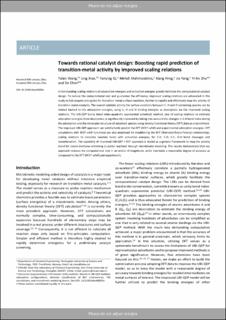| dc.contributor.author | Wang, Yalan | |
| dc.contributor.author | Xiao, Ling | |
| dc.contributor.author | Qi, Yanying | |
| dc.contributor.author | Mahmoodinia, Mehdi | |
| dc.contributor.author | Feng, Xiang | |
| dc.contributor.author | Yang, Jia | |
| dc.contributor.author | Zhu, Yi-An | |
| dc.contributor.author | Chen, De | |
| dc.date.accessioned | 2020-07-07T08:34:20Z | |
| dc.date.available | 2020-07-07T08:34:20Z | |
| dc.date.created | 2019-09-29T13:29:43Z | |
| dc.date.issued | 2019 | |
| dc.identifier.citation | Physical Chemistry, Chemical Physics - PCCP. 2019, 21 (35), 19269-19280. | en_US |
| dc.identifier.issn | 1463-9076 | |
| dc.identifier.uri | https://hdl.handle.net/11250/2660912 | |
| dc.description.abstract | Understanding the scaling relations of adsorption energies and activation energies greatly facilitates the computational catalyst design. To reduce the computational cost and guarantee efficiency, improved scaling relations were advocated in this study to rapidly acquire the energetics for transition metal surface reactions and further to rapidly and effectively map the activity of transition-metal catalysts. The overall catalytic activity for the surface reactions between C-, H- and O-containing species could be related to their adsorption energies using C, H and O binding energies as descriptors via improved scaling relations. The UBI-QEP (unity bond index-quadratic exponential potential) method, one of the scaling relations used to estimate the adsorption energies from descriptors, was significantly improved by taking into account the changes in the A–B bond indexes during adsorption and the molecular structure of adsorbed species using density functional theory (DFT) data as a benchmark. The improved UBI-QEP approach could satisfactorily predict the DFT (BEEF-vdW) and experimental adsorption energies. DFT calculations with the BEEF-vdW functional were also employed for establishing the BEP (Brønsted–Evans–Polanyi) relationships as scaling relations to correlate the reaction heats with activation energies for C–H, C–O, C–C, and O–H bond cleavages and recombination. The capability of the improved UBI-QEP+BEP approach was tested as a generic framework to map the activity trend for steam methane reforming (a probe reaction) through microkinetic modeling. The results demonstrated that our approach reduces the computational cost by six orders of magnitude while maintaining a reasonable degree of accuracy as compared to the DFT (BEEF-vdW) and experimental approaches. | en_US |
| dc.language.iso | eng | en_US |
| dc.publisher | Royal Society of Chemistry | en_US |
| dc.title | Towards rational catalyst design: boosting the rapid prediction of transition-metal activity by improved scaling relations | en_US |
| dc.type | Peer reviewed | en_US |
| dc.type | Journal article | en_US |
| dc.description.version | acceptedVersion | en_US |
| dc.source.pagenumber | 19269-19280 | en_US |
| dc.source.volume | 21 | en_US |
| dc.source.journal | Physical Chemistry, Chemical Physics - PCCP | en_US |
| dc.source.issue | 35 | en_US |
| dc.identifier.doi | 10.1039/c9cp04286e | |
| dc.identifier.cristin | 1730791 | |
| dc.relation.project | Norges forskningsråd: 237922 | en_US |
| dc.description.localcode | © 2019. This is the authors' accepted and refereed manuscript to the article. Locked until 7.8.2020 due to copyright restrictions. The final authenticated version is available online at: http://dx.doi.org/10.1039/c9cp04286e | en_US |
| cristin.unitcode | 194,66,30,0 | |
| cristin.unitname | Institutt for kjemisk prosessteknologi | |
| cristin.ispublished | true | |
| cristin.fulltext | preprint | |
| cristin.qualitycode | 2 | |
